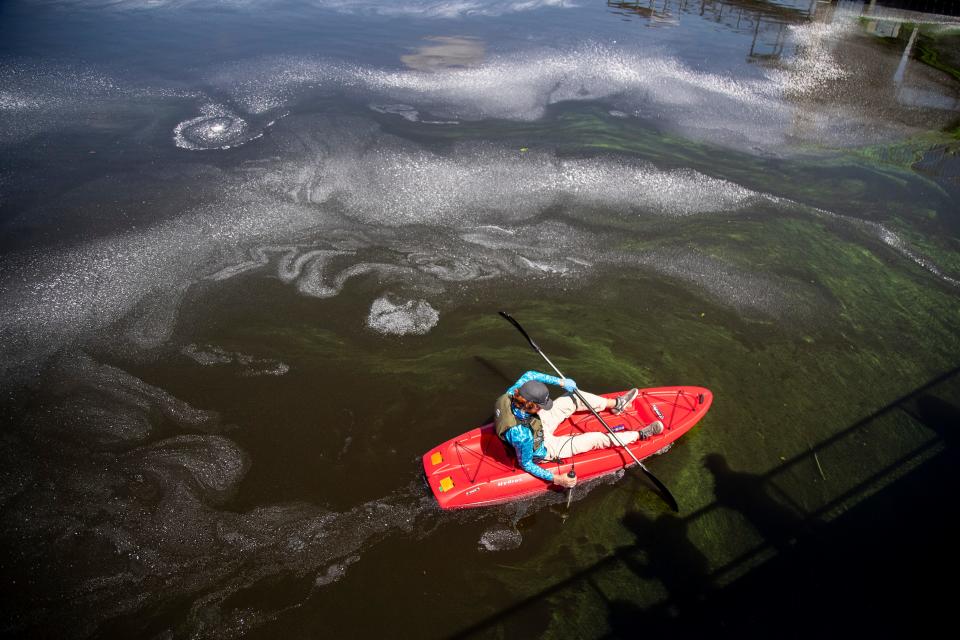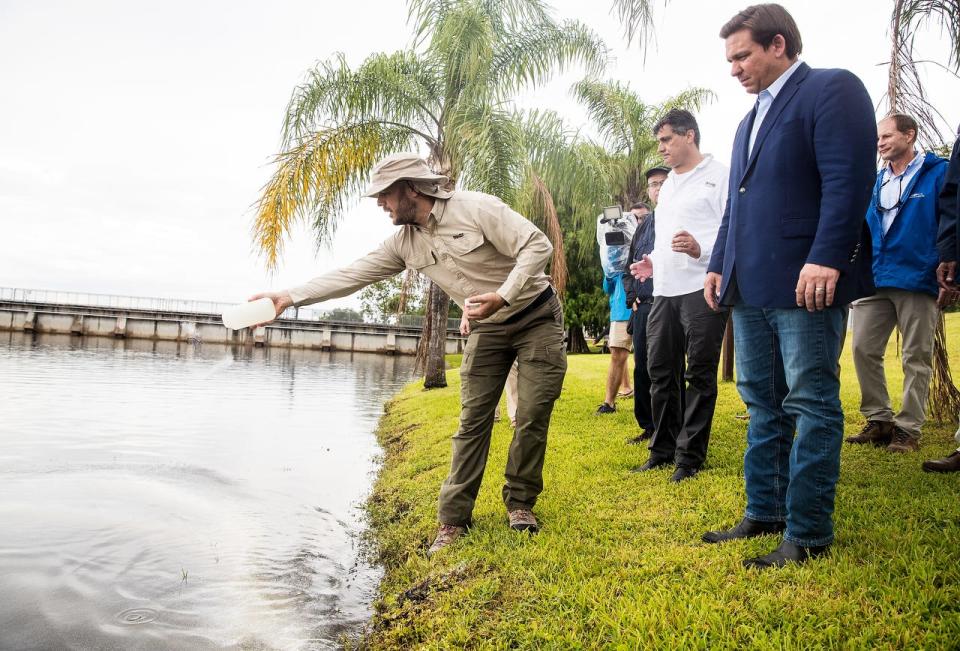Algaecides kill toxic algae blooms, but are they safe and effective long-term?
The ammonia-reeking, guacamole-green algae that fouled Timer Powers Park in Indiantown in August was 100 times more toxic than the Environmental Protection Agency deems unsafe for pets and people. But one day after the state treated the bloom with an algaecide, the toxicity had dropped below the unsafe level.
The South Florida Water Management District has used Lake Guard Oxy to kill toxic algae since 2021, but only just began to study whether it's safe for the environment. The powder, containing sodium percarbonate, is less toxic in the water than it is upon direct contact.
Scientists are concerned it can kill plants and animals, including bees, birds, fish, shellfish and beneficial algae. They also question the $12.50 per pound cost, human safety, long-term effectiveness and feasibility of treating a large waterway like 730-square-mile Lake Okeechobee.
“Our concern is how it affects the other plankton algae communities,” said Stuart-based Florida Oceanographic Society Executive Director Mark Perry. “You wouldn’t want to do it in an estuary or shallow area where shellfish could possibly be affected by it.”
Are algaecide treatments effective?
Toxic algae blooms have returned to treated or nearby areas within two weeks, scientists say.
“It's like putting a Band-Aid on it,” Perry said. “It looks good for now, and it might heal up in that one spot, but you might get a cut somewhere else.”
On Aug. 8, the SFWMD spent $1,825 treating one acre of Timer Powers Park with 126 pounds of Lake Guard Oxy — more than the recommended 30-98 pounds for heavy blooms, but half the maximum amount of 294 pounds. By Aug. 9, the microcystin toxin in the algae had decreased from 800 to 5.6 parts per billion. The EPA deems over 8 ppb unsafe.
Lake Guard Oxy also was used in:
October 2020: The state paid Bluegreen Water Technologies $945,000 to treat the Port Mayaca dam area, as toxic algae-laden Lake O water entered the C-44 Canal.
May 2021: The state paid Bluegreen Water Technologies $750,000 to treat the W.P. Franklin dam area in the Caloosahatchee River. Toxic algae returned to unsafe levels three weeks after repeated treatments.
The SFWMD has used 8,217 pounds of Lake Guard Oxy in Lake O since 2021, including about 2,000 pounds in 11 treatments in August, which is about 24% of the total use, according to the SFWMD. It cost the state $150,452.
It is not feasible or environmentally safe to treat the entire lake, said Florida Gulf Coast University professor Hidetoshi Urakawa, who has studied hydrogen peroxide-based algaecides since 2017.
“The hydrogen peroxide is the best short-term treatment,” Urakawa said. “But if we treat the entire lake, there's no place for the fish to hide if they don't like it. If the concentration is totally wrong, there is a risk for fish and other aquatic organisms.”
How does Lake Guard Oxy work?
The algaecide super-oxygenates the water, which ruptures algae cells, then bacteria feast on the released toxins, Urakawa explained. “Their metabolism is screwed," he said, adding the hydrogen peroxide makes the algae "sick."
The EPA and some scientists are concerned about the bacteria frenzy and decaying algae depleting oxygen in the water, which can kill fish and plants.
Oxygen levels return to normal once the algaecide dissipates, according to Urakawa and SFWMD water resources director Lawrence Glenn, who also said beneficial algae are at less risk because they have stronger cell walls than microcystis. Still, the SFWMD is studying the algaecide's efficacy and ecological impact.
"To have a label, it has to have done studies," Glenn said of BlueGreen Water Technologies, the maker of Lake Guard Oxy. "We want to ensure ourselves that we are using the correct product.”

Some experts are skeptical and wary of using algaecides in the St. Lucie River.
“Any soft-bodied algae that just has a simple cell membrane is going to be susceptible to oxidation,” said James Sullivan, a member of the Florida Blue Green Algae Task Force and executive director of Florida Atlantic University’s Harbor Branch Oceanographic Institute in Fort Pierce. “A high enough concentration can definitely kill a variety of algae. So it's not specific to blue-green algae.”
Martin County Ecosystem Restoration Manager John Maehl said he's not concerned about using the algaecide in the manmade C-44 Canal that connects the river to Lake O, running past Timer Powers Park.
“Where we would have continued significant concerns is if they’re considering applying it in the (river) because we do know that bivalves like clams and oysters are more susceptible than fish,” he said.

The task force, created and appointed by Gov. Ron DeSantis, recommends preventing algae over treating it. One way is by reducing nitrogen and phosphorus pollution, primarily from agricultural fertilizer and secondarily from lawn fertilizer and leaky septic tanks. DeSantis budgeted $10 million on "innovative technologies" to combat the toxic algae in the 2023-24 state budget and $20 million the year before.
“We don't need to keep on throwing chemicals into the water,” Sullivan said. “We can just get (our water) clean naturally and stop the nutrient pollution that will go a long way.”
Katie Delk is TCPalm's environment reporter. Contact her at katie.delk@tcpalm.com or 772-408-5301. Check for updates @katie_delk.
This article originally appeared on Treasure Coast Newspapers: Algaecides kill toxic algae blooms, but are they safe and effective?

